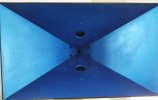+1
If you don't allow for the extra headroom you will have the compressed sound that so many associate with LOUD music. With a system that has ~10dB of dynamic headroom you can play music at realistic levels without it sounding LOUD.
This has been a principal requirement for me, after having heard LOUD music that stays linear with low distortion, even for the dynamic headroom needed.
It's so amazing to me, how higher SPL just keeps sounding better, and how high the dang SPL meter reads, when a system truly maintains linear response throughout the spectrum.
I say dang SPL meter, because it's often a wake up alarm to limit the listening duration !
The acid test imo, in determining a systems max linear SPL capability, is simply at what measured average SPL level does it starting sounding loud. That simple.
Don't even have to measure it with the new AES75 Max SPL standard (adopted from M-Noise)......ears work just as well haha
Most domestic hi-fi speakers come up short in this area even in much more modest rooms. I would look at the more refined horn based systems, if these SPLs are important to you.
FWIW: The Wisdom and Steinway Lyngdorf systems I mentioned previously are also quite capable of achieving these SPLs in your room, but both are large and expensive.
Wan't to say I enjoy your comments, and the upper echelon commercial home-audio models posts.
I rarely look at home audio, being entirely into DIY and mainly exploring proaudio for technological advances.
One thing I'd add about the Wisdom and Steinway models....both will require their subs, as part of their system...
(And I do wonder if the Steinway can pull off the large space. The only sub offering I saw was a sealed dual 12"....could take quite a few of them stacked together)
Imo, NO system wanting to make 90+ dB @ 20ft in a large room, that extends down to at least 30Hz, and with linear dynamic headroom,.... ...
will be able to do so without sub(s), or the their equivalents output somehow imbedded into the main speaker.
It takes driver displacement ime, or efficiency gains from horn loading, to go both deep and loud. No getting around it, I think.
Setting aside horns for a second, on the conventional cone side I am leaning towards the perlisten s towers towers due to their high sensitivity, the MTM configuration to reduce vertical reflections and the lowest distortion figures that I believe exist for a cone speaker (meaning the maximum amount of headroom before compression). What gives me pause, is the necessity of subwoofers, and the wider than horn horizontal directivity.
Since moving on from my big Meyer's I posted about earlier, all my speaker focus has been on DIY, particularly on larger unity/synergy builds.
Here's an example of one without secondary flares. (for use with sub)

One handy rule of thumb I've learned is Don Keele's classic pattern control formula.
Where lowest frequency of pattern control = 1,000,000 / (mouth size in inches x horn pattern angle in degrees.
So the blue guy above has a 90 degree horizontal, 60 degree vertical pattern. And is 33" wide z 22" tall.
By the formula, horizontal control holds to about 300Hz . 1,000,000 / (90x33)= 309
And vertical holds to about 750 Hz 1,000,000 / (60x22) = 758
Ok, why bring this up? It's for horns, but I've found it holds up well for waveguides too.
You can apply it to your JBLs and see pattern control is letting go both H&V around 1000Hz.
I've found the ROT very helpful in evaluating any speaker that incorporates a waveguide or horn.
If patten control is important to you, just like there's "no replacement for displacement for direct radiating subs",
my experience is there's no replacement for size when it comes to pattern control.
Hope that all made sense..

